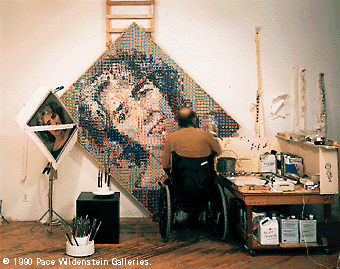

Over the years he achieved full-time fame, but his body started showings signs of betraying him well before that terrible day in 1988. Several times in his life, he experienced excruciating pain but doctors couldn't find a reason.
Then came Dec. 7, 1988. He was in his Upper West Side apartment, alone. His wife, Leslie, was at work. Their two daughters, Georgia and Maggie, were at school. The mysterious pain came back and he dropped to the floor. The pain subsided but later, at an event at the mayor's residence, he didn't feel right. He made an award presentation, then promptly left for a nearby hospital.
The doctors didn't know what was going on. He had a long, violent convulsion, his hands and legs flailing about. He had to be held down, and then he stopped moving--yet never lost consciousness. The doctors thought it was a cardiac problem. Days later, he was transferred to the NYU Medical Center. Close was in sorry shape--only the top quarter of each lung worked. His lungs were suctioned every two hours, he could barely breathe, his diaphragm stopped working, his bladder didn't work, his limbs were numb.
Eventually, doctors discovered a blood clot in his spinal column. It was high up in his neck and damaged the spinal cord, causing his paralysis. Had it been an inch higher, he would have died. An inch lower, and he would have minimal paralysis.
"Have you ever been in a car wreck, with the car spinning out of control," he asks. "You know that strange eerie calmness that takes over as you almost go into slow motion? You turn the wheel this way, that way. Only when it's over do you fall apart and go into shock. This was an attenuated, drawn-out case of that, where many days I experienced a profound calmness, eerie even to me."
In early 1989, he began a grueling rehabilitation program but was feeling hopeless. Then his wife insisted that Close get back to painting. At first, he held a brush between his teeth and he could control it enough to paint. "I suddenly became encouraged," he says. "I tried to imagine what kind of teeny paintings I could make with only that much movement. I tried to imagine what those paintings might look like. Even that little bit of neck movement was enough to let me know that perhaps I was not powerless. Perhaps I could do something myself."
Later, he regained some movement in his upper arm, and his therapists fashioned a hand split onto which they could tape a paint brush. At first, he used gloppy poster paint. With great effort, Close drew a primitive grid on the cardboard. He could barely move the upper portion of his arms. He moved the brush around in the paint for as long as he could bear it--usually one or two seconds--and he then attempted to daub it into the space of the grid he made.
It was the birth of a new style that has earned Close fame and fortune equal to what he enjoyed prior to his tragedy.

He was making lozenge shapes with the paint brush strapped to his hand. "I saw that each grid was in fact a tiny painting," he says. "I thought about making little teeny paintings. I'll paint in my lap little two-inch paintings backed with Velcro and then they'll all go together on the wall like a big jigsaw puzzle. It will eventually build a big picture. I didn't want to lose the scale of my work. This would address the problem of how I'd build a big painting. I'd paint little pictures and then have assistants mount them on the wall."
His work blossomed from there. His paintings this time were much more colorful and the image was much softer. "This was the path I had been on, this dissolution of the image. I realized that all I had done was catch up in my work with where I had been," he says.
His new system of painting added a wide range of brilliant color, and, according to Roger Angell writing in The New Yorker, "a ravaged artist has become, in a miracle, one of the great colorists and brush wielders of his time."
His life is a struggle but it has its rewards. In his custom studio, the boy from Monroe whom no one thought would amount to anything paints dazzling, huge works from his wheelchair, enthralling art enthusiasts and critics alike. * Jon Marmor is associate editor of Columns.
Return to the Beginning of "Close Call"
Return to Finding His Own Voice Through Photorealism
Return to Life as a UW Student: Bald at 20
Chuck Close's Gallery and Contact Information
Send a letter to the editor at columns@u.washington.edu.